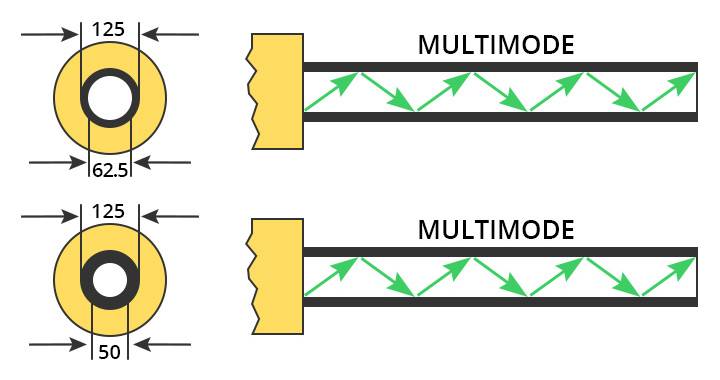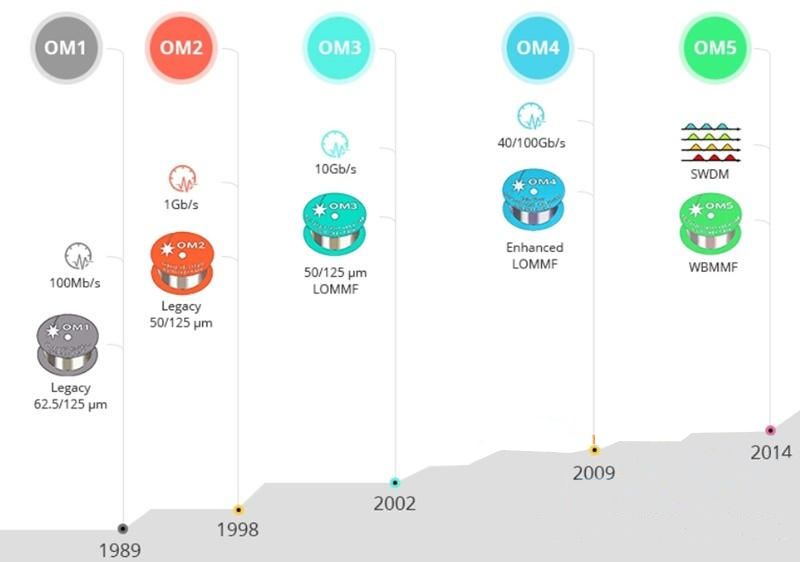According to the different modes of optical signal transmission within the fiber, optical fibers can be divided into single mode fiber and multi mode fiber.
What is multimode fiber
Multimode fiber is G.651 fiber, it is mainly used in short distance communication, such as interconnection between devices in data centers, inner buildings or campus or other scenarios. You can know all optical fibers in article:”7 Types of optical fiber”.
Mulitmode fiber have a bigger fiber core 50um or 625.um, can transimit mulitmode fiber modes. In a given time, more data can pass through a multimode fiber core, and mulitmode cable have a max. distance of 550m at 10Git/s, and 2km at 100Mb/s.

Multimode fiber types
According to the material, multi-mode fiber is divided into glass fiber and plastic fiber. Plastic optical fibers are mainly used in industrial control and automotive entertainment systems, accounting for a relatively low percentage overall.
According to ISO 11801 standard, communication commonly used is glass fiber, and the multimode fiber can be divided into OM1 fiber, OM2 fiber, OM3 fiber, OM4 fiber and OM5 fiber. Following will compare these fibers in detail in terms of core size, bandwidth, data rate, distance, color and light source.

OM1 Fiber
OM1 fiber is with orange cable jacket, and core 62.5 µm. It can support 10 Gigabit Ethernet up to 33 meters and is most commonly used in 100 Mbit Ethernet applications. And OM1 fiber typically uses an LED light source.
OM2 Fiber
OM2 fiber is with orangecable jacket and smaller core 50um. It supports up to 10 Gigabit Ethernet up to 82 meters, but is more commonly used in 1 Gigabit Ethernet applications. OM2 fiber use an LED light source too.
OM3 Fiber
OM3 fiber is with green cable jacket, and 50 µm core size, but OM3 cable is optimized for laser-based devices and supports 10 Gigabit Ethernet up to 300 meters. Furthermore, it support 40 Gigabit and 100 Gigabit Ethernet up to 100 meters. And there are OM3-150 and OM3-300 difference.
OM4 Fiber
OM4 fiber is fully backward compatible with OM3 fiber and shares the same distinctive violet or purple jacket. OM4 was developed specifically for VSCEL laser transmission, which allows up to 550m 10 Gig/s link distance compared to 300M for OM3. Besides, OM4 fiber support 40/100GB up to 150 meters by using MPO MTP connectors.
OM5 Fiber
OM5 fiber, also known as WBMMF (Wideband Multimode Fiber), is the latest multimode fiber, backward compatible with OM4. It has the same core size 50um as OM2, OM3 and OM4. The OM5 fiber cable jacket color is lemon green.
OM5 fiber is designed and specified to support at least four WDM channels at a minimum speed of 28Gbps per channel through the 850-953 nm window.
Let’s see all the difference from below table:
| Fiber type | OM1 | OM2 | OM3 | OM4 | OM5 |
| Core size | 62.5um | 50um | 50um | 50um | 50um |
| Cable color | Orange | Orange | Aqua | Aqua or violet | Lemon green |
| Bandwidth | 200MHz*km | 500MHz*km | 2000MHz*km | 4700MHz*km | 28000MHz*km |
| Data rate | 100Mb/s | 1Gb/s | 10Gb/s | 40Gb/s, 100Gb/s | SWDM(28Gbps) |
| Multimode fiber distance at 10G | 33meter | 82meter | 300meter | 550meter | 550meter |
| Light source | LED | LED | VSCEL | VSCEL | VSCEL |
| Year launch | 1989 | 1998 | 2002 | 2009 | 2014 |
| Application | 100M Ethernet | 1Gigabit Ethernet | 10Gigabit Ethernet (it can also support 100meter at 40G/100G) | 10Gigabit/s (150meter with MPO/MTP connector) | (440meter in 40G, 150meter in 100G) |
Advantages of multi mode fiber
- Multiuser framework without lossy interference
Multimode fiber carry multiple signals in the same line at the same time. Most importantly, the total power inside the signal is almost no loss. Therefore, network users can send multiple data packets in the cable at the same time, and all information will be transmitted to the destination without any interference and remain unchanged.
- 2.Support multiple protocols
Multimode fiber can support a variety of data transmission protocols, including Ethernet, Infiniband and Internet protocols. Therefore, people can use cables as the backbone of a series of high-value applications.
- 3.High cost performance
With a larger fiber core and good alignment tolerance, multi mode fiber and components are cheaper and easier to work with other optical components (such as fiber connectors and fiber adapters), and the cost of operation, installation and maintenance of multi mode patch cords is lower than that of single-mode fiber cables.
Multimode fiber color
The original fiber is transparent, no color, but in order to ease distinguish when mass production and on site construction, will add color on the fiber optic cable outer jacket / sheath or housing of fiber optic connectors. However, the color can be customize according to your request.
The international standard for multimode fiber color are: OM1 fiber orange, OM2 fiber orange, OM3 fiber aqua, OM4 fiber aqua or violet, OM5 lemon green.
| Fiber type | OM1 | OM2 | OM3 | OM4 | OM5 |
| Cable sheath color | Orange | Orange | Aqua | Aqua or violet | Lemon green |
| Connector color | Beige | Beige | Aqua/beige | Aqua/violet | Lemon green |
Multimode fiber optic connector application
The most common types of multimode fiber optic connectors include ST, SC, FC, LC, MU, E2000, MTRJ, SMA, DIN, and MTP & MPO. Each has its own advantages, disadvantages, and applications.
| Connector typ | Ceramic ferrule size | Insertion loss (dB) | Application Features |
| SC | φ2.5mm | 0.25~0.5dB | Mainstream, reliable, rapid deployment, on-site adaptation |
| LC | φ1.25mm | 0.25~0.5dB | High-density, cost-effective, on-site installation |
| FC | φ2.5mm | 0.25~0.5dB | High precision, vibration environment, on-site adaptation |
| ST | φ2.5mm | 0.25~0.5dB | Military fitness |
| MTP/MPO | φ2.5mm | 0.25~0.5dB | High-density integrated system, such as data center |
Note:
The ferrule refers to the precise centering cylinder in the optical fiber connector, with a micro hole in the center, which is used for fixing the optical fiber. According to the different materials used for the ferrule, it can be divided into ceramic ferrule, glass ferrule, plastic ferrule and metal ferrule.
What is difference between single and multimode fiber?
Although single-mode fiber patch cords have advantages in bandwidth and transmission distance, multimode fiber can easily support most of the distance required by enterprise and data center networks, and the cost is far lower than single-mode fiber. In addition, multimode optical cables have many obvious advantages.
| Technical difference | |
| Core diameter | The core diameter of single-mode fiber is very small (8.3 to 10 microns), allowing only one mode of light propagation. The multimode fiber optic cable has a large diameter core (50 to 100 microns), allowing multiple optical modes to propagate. |
| Light source | Multi-mode equipment usually uses LED or laser as the light source, while single-mode equipment uses laser or laser diode to generate the light injected into the cable. |
| Actual difference | |
| Distance | The propagation distance of light in single-mode cable is longer than that in multimode cable, so multimode fiber is suitable for short-distance applications, and the transmission distance can reach about 550m at 10Git/s. When the distance exceeds 550m, single-mode fiber is preferred. |
| Price | The cost of multimode fiber is usually lower than that of single-mode fiber.Bandwidth:The bandwidth of single mode is higher than that of multimode, up to 100000 GHz |
Conclusion
Due to its high capacity and reliability, multimode fiber is often used in backbone applications in buildings and MMF cables are still the most cost-effective choice for enterprise and data center applications up to 500-600 meters.
But this does not mean that we can replace singlemode fiber with multimode fiber.
And how to choose singlemode fiber patch cord or multimode patch cord, it all depends on the application you need, the transmission distance, and the coverage allowed by the total budget.
FAQ
Does multimode fiber use LED or laser?
Yes, OM1 and OM2 use LED light source, and OM3 OM4 OM5 use VSCEL laser.
How far can 10 gig multimode fiber go?
Mulitmode fiber distance vary due to fiber mode, for example at 10Gigabit/s:
- OM1 can transmit 33 meters,
- OM2 can transmit 82 meters,
- OM3 can transmit 300 meters,
- OM4 can transmit 550 meters,
- OM5 can transmit 550meter,
that is OM4 and OM5 is the longest, and OM1 is shortest. And 10Gig mulitmode fiber can go maximum 550 meters, and the max distance for multimode fiber is 550 meters.
What is the max distance for multimode fiber?
If use fast Ethernet, the max distance for multimode fiber is 1000km, if in 10G Etnernet, the max distance is 55ometers.
What is the distance limit for OM3?
OM3 multi mode fiber in 10 Gbs can transmit maximum distance about 300 meters (1000 ft) before the signal becomes indistinguishable.
Does OM3 fiber support 10G?
Yes, OM3 and OM4 multi-mode fibers are mostly used for 10G/40G data center fiber cabling. OM4 is the update version of OM3 fiber, and it can fully compatible with OM3.

